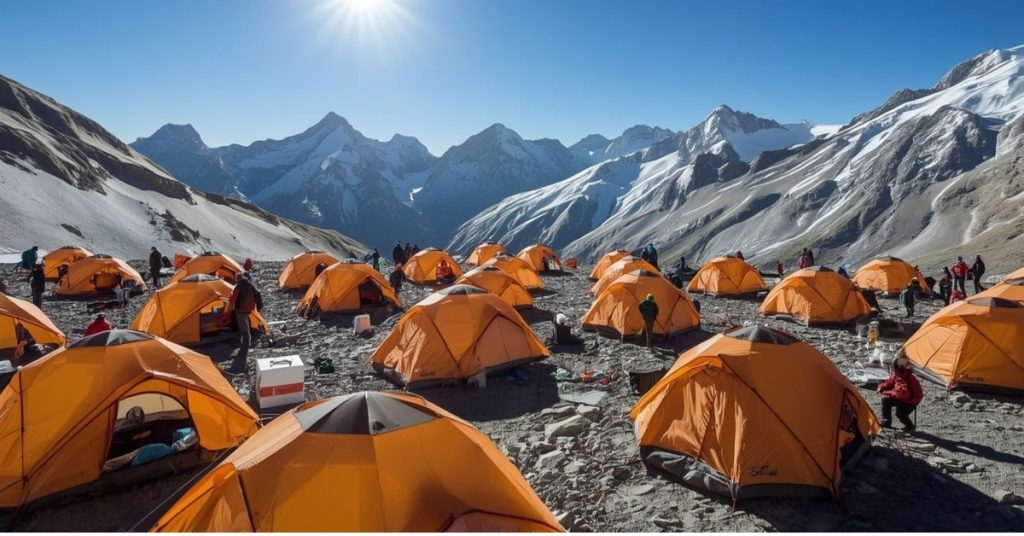As an Amazon Associate, I earn from qualifying purchases.
Venturing into the mountains is exciting, but high altitude comes with real challenges. Reduced oxygen levels can trigger headaches, fatigue, or even altitude sickness if your body isn’t prepared. That’s where acclimatisation becomes essential—it allows you to adapt gradually, improving both safety and performance.
High altitude tents provide a powerful tool for this process. By replicating the thinner air you’ll face on peaks and passes, these tents help your body adjust before you ever leave home. Whether you’re preparing for Everest Base Camp, tackling a 14er in Colorado, or gearing up for ski season in the Alps, learning how to use an altitude tent correctly can mean the difference between a successful adventure and a dangerous setback. This guide will walk you through the science, the setup, and the strategies for effective acclimatisation.
Contents
Why Acclimatisation Is Crucial at High Altitude

Your body functions perfectly at sea level, where oxygen makes up about 21% of the air you breathe. As you ascend, atmospheric pressure drops, and while oxygen percentage remains the same, there’s simply less available oxygen in each breath you take.
Without proper acclimatisation, you risk developing altitude sickness, which ranges from mild symptoms like headaches and nausea to life-threatening conditions. Acute Mountain Sickness (AMS) affects up to 80% of people who ascend rapidly above 8,000 feet. More severe forms include High Altitude Pulmonary Edema (HAPE) and High Altitude Cerebral Edema (HACE), both potentially fatal if left untreated.
The Body’s Natural Adaptation Process
When exposed to lower oxygen levels, your body initiates several remarkable adaptations. Your breathing rate increases to take in more air, your heart pumps faster to circulate oxygen more efficiently, and most importantly, your body begins producing additional red blood cells to carry more oxygen throughout your system.
This process takes time—typically days to weeks depending on the altitude and individual factors. Rushing this adaptation is where many mountaineers and high-altitude travelers run into serious trouble.
Performance and Comfort Benefits
Proper acclimatisation doesn’t just prevent illness; it dramatically improves your experience at altitude. Well-acclimatised climbers report better sleep quality, improved physical performance, clearer thinking, and greater enjoyment of their high-altitude activities.
How High Altitude Tents Support Acclimatisation

High altitude tents work by creating a controlled hypoxic (low-oxygen) environment. They use specialized systems to reduce the oxygen concentration inside the tent, effectively simulating conditions you’d experience at various elevations.
The Science Behind Simulated Altitude
These tents typically reduce oxygen levels from the normal 21% down to anywhere from 15% to 10%, depending on the altitude being simulated. A 15% oxygen environment simulates approximately 9,000 feet, while 10% oxygen mimics conditions around 18,000 feet.
The controlled environment allows you to experience hypoxic stress in a safe setting where you can monitor your response and adjust exposure as needed. Unlike actual altitude exposure, you can immediately return to normal oxygen levels if you experience any concerning symptoms.
Convenience and Safety Advantages
Training at home eliminates many variables that complicate high-altitude acclimatisation. You don’t need to worry about weather, terrain, or being far from medical care. You can maintain your normal nutrition, hydration, and sleep schedule while gradually adapting your body to lower oxygen levels.
The portability of these tents also makes them valuable for staged acclimatisation during actual expeditions, allowing climbers to maintain their adaptation even when descending to lower camps.
Step-by-Step Guide to Tent Acclimatisation

Proper acclimatisation is key to high-altitude success. Follow this streamlined guide to effectively use altitude tents, ensuring safe and optimal adaptation
Step 1: Medical Consultation
Before beginning any altitude training program, consult with a healthcare provider, especially if you have any cardiovascular, respiratory, or blood-related conditions. Certain medications and health conditions can affect your body’s response to hypoxic training.
Your doctor can help determine if high altitude tent training is appropriate for you and may suggest baseline tests to monitor your adaptation progress.
Step 2: Start with Conservative Sessions
Begin with 1-2 hour sessions at the lowest simulated altitude setting (typically around 8,000-9,000 feet). Many people make the mistake of starting too aggressively, which can lead to unnecessary discomfort or even adverse reactions.
Schedule your initial sessions during times when you can rest afterward, such as evenings before bed or during periods when you don’t have demanding physical or mental activities planned.
Step 3: Progressive Increase
Gradually increase both your tent time and simulated altitude over weeks. A typical progression could be:
- Week 1: 1-2 hours at 8,000 feet
- Week 2: 2-3 hours at 10,000 feet
- Week 3: 3-4 hours at 12,000 feet
- Week 4: 4-6 hours at your target altitude
Adjust based on your body’s response and your expedition timeline.
Step 4: Monitor Your Health Vigilantly
Watch for symptoms of altitude sickness even in simulated conditions: headaches, nausea, dizziness, fatigue, or sleep disturbances. Mild symptoms are normal initially, but severe or worsening symptoms warrant immediate session termination and possibly medical consultation.
Keep a training log noting session duration, simulated altitude, how you felt during and after sessions, and any symptoms experienced.
Step 5: Maintain Optimal Support Conditions
Proper hydration becomes even more critical during hypoxic training. Dehydration compounds altitude effects and can mask important warning signs. Aim to drink water regularly before, during, and after sessions.
Nutrition also plays a crucial role. Avoid alcohol entirely during training periods, as it can interfere with your body’s adaptation mechanisms and increase altitude sickness risk.
Step 6: Integrate with Physical Training
High altitude tent sessions work best when combined with appropriate physical conditioning. However, avoid intense exercise immediately before or during tent sessions, as this can overwhelm your system’s ability to adapt safely.
Plan rest days between intensive tent sessions, especially when increasing altitude or duration. Your body needs recovery time to build the physiological adaptations that improve altitude performance.
Step 7: Supplement, Don’t Replace Real Altitude
While high altitude tents provide excellent preparation, they can’t perfectly replicate every aspect of high-altitude exposure. If possible, combine tent training with some actual altitude exposure before your main expedition.
Many climbers use tents for initial adaptation, then spend time at intermediate altitudes before attempting their primary objective.
Maximizing Your Acclimatisation Benefits
Boost your acclimatisation by prioritizing hydration, nutrition, and quality sleep. Eliminate alcohol and smoking to improve oxygen efficiency. Add light exercise and rest to accelerate adaptation. Combine these with your altitude tent training for optimal performance and quicker recovery.
Lifestyle Considerations During Training
Alcohol and smoking significantly impair your body’s ability to adapt to altitude. Alcohol disrupts sleep quality and interferes with respiratory function, while smoking reduces your blood’s oxygen-carrying capacity—exactly the opposite of what you’re trying to achieve.
Sleep quality affects adaptation, so maintain good sleep hygiene. Many users find that tent sessions before bedtime can be particularly effective, as the body continues adaptation processes during sleep.
Monitoring Your Progress
If available, use a pulse oximeter to track your blood oxygen saturation during sessions. This provides objective data about how your body is responding to simulated altitude. Normal sea-level saturation is 95-100%, while well-acclimatised individuals might maintain 85-90% at altitude.
Heart rate variability monitors can also provide insights into your body’s stress response and recovery between sessions.
Recognizing When to Adjust
Consistency matters more than intensity. If you’re struggling with your current protocol, it’s better to maintain a manageable level longer than to push too hard and potentially set back your adaptation.
Progressive overload applies to altitude training just like physical exercise—small, consistent increases produce better results than dramatic jumps that overwhelm your system.
Potential Risks and Precautions
High altitude tents pose risks like dehydration, fatigue, and worsened altitude sickness if overused. Start slow, listen to your body, and stop if symptoms worsen. Those with heart or respiratory issues must consult a doctor. Tents simulate altitude, but they don’t mimic all environmental factors—use them wisely as part of a comprehensive prep plan.
Understanding the Limitations
High altitude tents create hypoxic conditions but can’t replicate other altitude factors like cold, wind, physical exertion at elevation, or the psychological challenges of high-altitude environments. Don’t assume tent training alone will prepare you for every aspect of high-altitude activities.
Some individuals are naturally more or less responsive to altitude training. Genetic factors, fitness level, and previous altitude exposure all influence how effectively you’ll adapt.
When to Stop or Seek Help
Discontinue sessions immediately if you experience severe headaches, persistent nausea, confusion, difficulty breathing, or any symptoms that concern you. These could indicate that your training intensity exceeds your body’s current adaptation capacity.
If symptoms persist after returning to normal oxygen levels, consult a healthcare provider before resuming training.
Planning Your Training Timeline
Most experts recommend 4-6 weeks of consistent tent training before significant altitude exposure. However, some adaptation benefits can be seen within 1-2 weeks for moderate altitude activities.
For major expeditions like Himalayan climbing, many mountaineers begin tent training 2-3 months before departure, allowing time to build substantial physiological adaptations and identify any individual challenges with altitude exposure.
Final Verdict
High-altitude tent acclimatisation provides a safe and effective way to prepare your body for the challenges of thinner air and reduced oxygen. Success comes from patience, consistency, and careful self-monitoring, as each individual responds differently to altitude. Start early, progress gradually, and adjust your approach to match your body’s signals.
Remember, tent acclimatisation should be part of a broader preparation plan that includes physical conditioning, proper gear, and, when possible, exposure to real altitude. By taking these steps, you not only protect your health but also increase your chances of enjoying a successful and memorable adventure. Prepare wisely, and the mountains will reward you with both safety and unforgettable experiences.
Frequently Asked Questions
How long should I use a high altitude tent to acclimatise?
Most people benefit from 4–6 weeks of progressive training, starting with 1–2 hour sessions and building up to 6–8 hours at your target simulated altitude. Some adaptation can occur in as little as 1–2 weeks for moderate altitude activities.
Can I fully acclimatise using only a high altitude tent?
No, tents alone cannot fully replicate high-altitude exposure. They help with oxygen adaptation, but factors like cold, physical exertion, and psychological stress require actual time at elevation. Combining tent training with real altitude exposure gives the best results.
Are there risks to using simulated altitude tents?
Yes, risks include mild altitude sickness symptoms, dehydration, and complications for people with certain medical conditions. Use the tent conservatively at first, monitor your body’s response, and consult a healthcare provider if you have health concerns.
Can pregnant women use high altitude tents?
No, pregnancy is generally considered a contraindication for altitude training because of potential effects on fetal oxygen supply. Pregnant women should avoid altitude tents unless specifically cleared by a healthcare provider.
Do high altitude tents improve athletic performance?
Yes, they can improve performance by increasing red blood cell production and oxygen efficiency, especially for athletes competing at altitude. However, performance gains at sea level are usually modest and temporary.
As an Amazon Associate, I earn from qualifying purchases.
